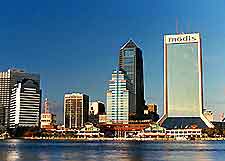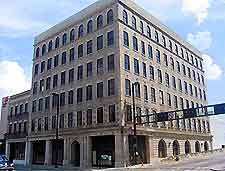Jacksonville History Facts and Timeline
(Jacksonville, Florida - FL, USA)

Spanish explorers and missionaries were the first Europeans to arrive in the St. Johns River area, followed by the French in 1562. Prior to that, the Mocama Native American tribe inhabited the Jacksonville area sparsely. The French Huguenots built Fort Caroline at St. Johns Bluff in 1564, but the fort was lost to the Spanish later that same year, after which time its name was altered to Fort San Mateo. The settlement changed hands from the Spanish to the British in 1763, but returned to Spanish control in 1783. It was then relinquished to the United States in 1821.
Even though Fort Caroline was destroyed by the Spanish, visitors can explore a replica of the fort today, which boasts a fascinating museum that highlights the history of early Jacksonville and life during the French occupation of the riverbanks.
The area grew in population during the early 1800s, being titled Jacksonville after the former US president and first territorial governor of Florida, Andrew Jackson, in 1822. The city was originally a predominantly agricultural economy, exporting oranges, cotton, timber and vegetables, and trading with the northern territories.
American Civil War History
The American Civil War (1861 to 1865) saw the city's port grow in importance, with Jacksonville becoming a strategic location for the Union Army, who gained control of it from 1862. After the war, the population of the city grew significantly with the influx of freed slaves, following the outlawing of slavery in 1865. The city hit an unexpected boom as tourism began to engulf the economy and it soon became a popular winter retreat for the wealthy. Jacksonville flourished throughout the late 1800s, but a devastating fire in 1901, the Great Fire, ravaged downtown.
Life after the Great Fire of 1901
Jacksonville was rebuilt after the fire, but this time in a concrete facade, leaving behind the 'frontier image' of the city's 19th-century history. The first paved access road to the beach was constructed in 1910 and the film industry prospered, becoming the industry's winter capital from the early 20th century until 1917, when it lost out to
Los Angeles. The Science and History Museum of Jacksonville holds interesting information about the history of the city around the turn of the 20th century.

Real Estate Boom
In the 1920s and the early '30s, Jacksonville went through a real estate boom that led to economic strength for the city. Two of the most prominent areas of growth during this time were the neighborhoods of Avondale and Riverside. Tourists can witness the beautiful residences and mansions located in these districts and take note of the different styles of architecture prominent within.
The city expanded in the 1920s, especially after the construction of bridges over St. Johns River, thereby opening up the southern banks for development. The rapid growth of Jacksonville attracted large banks and financial institutions in the 1930s and '40s, and by 1940, the city had a major naval presence in the form of the Naval Air Station Jacksonville, which today ranks as one of the largest naval bases in North America.
Post-1945
Following WWII, urban sprawl continued throughout the surrounding areas. A drain of the tax-paying middle class and a series of corruption scandals affected the city. In 1967, the Jacksonville and Duval County governments were consolidated, making this the largest city in Florida.
In 1993, the city was placed on the US sports map for good after it was awarded an NFL franchise - the Jacksonville Jaguars. Some 12 years later, in 2005, the city hosted the country's most prolific sporting event, the Super Bowl XXXIX.
 Spanish explorers and missionaries were the first Europeans to arrive in the St. Johns River area, followed by the French in 1562. Prior to that, the Mocama Native American tribe inhabited the Jacksonville area sparsely. The French Huguenots built Fort Caroline at St. Johns Bluff in 1564, but the fort was lost to the Spanish later that same year, after which time its name was altered to Fort San Mateo. The settlement changed hands from the Spanish to the British in 1763, but returned to Spanish control in 1783. It was then relinquished to the United States in 1821.
Spanish explorers and missionaries were the first Europeans to arrive in the St. Johns River area, followed by the French in 1562. Prior to that, the Mocama Native American tribe inhabited the Jacksonville area sparsely. The French Huguenots built Fort Caroline at St. Johns Bluff in 1564, but the fort was lost to the Spanish later that same year, after which time its name was altered to Fort San Mateo. The settlement changed hands from the Spanish to the British in 1763, but returned to Spanish control in 1783. It was then relinquished to the United States in 1821.